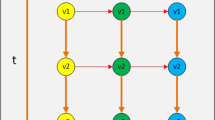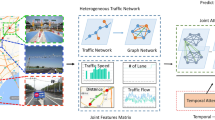Abstract
In this study, a dual-attention network (DAN) with multitask learning is proposed to solve the short-term prediction problems of traffic speed. The proposed DAN includes a road-type attention module (RAM), which performs accurate short-term speed prediction using road-type attention scores, a low-speed attention module (LAM), which is trained on weighted samples and fits low speed, and a decision support module, which outputs either RAM or LAM by estimating the level of the predicted speed. DAN can improve the transfer in the feature and speed prediction task layers by learning-associated and time-dependent tasks. The Shanghai expressway dataset is used to test and compare the proposed method and 15 other techniques. The results show that DAN with a multitask loss function obtains the smallest mean squared error (MSE) and mean absolute percentage error (MAPE) in most cases. LAM efficiently improves the predictive accuracy of low-speed samples, whereas RAM performs better in terms of the overall error reduction. DAN achieves the largest R-squared of 0.93 with a small reduction in R-squared by 0.12% from the training data to the test data, thereby illustrating its excellent generalization. DAN outperforms the other models by at least 13.5% in terms of the MSE and by 5.07% in terms of the MAPE on different road types. Adding LAM effectively improves the MAPE by at least 21.4% over RAM without increasing the error of the other speed levels. In terms of the MSE, RAM outperforms DAN by 12.6% in the best case. This study proved that the short-term speed prediction based on DAN has the ability to improve the accuracy on low-speed level and the generalization on different road types.













Similar content being viewed by others
References
Li T, Sun H, Wu J, Gao Z, Ge Y, Ding R (2019) Optimal urban expressway system in a transportation and land use interaction equilibrium framework. Transp A Transp Sci 15:1247
Yang Y, Li M, Yu J, He F (2020) Expressway bottleneck pattern identification using traffic big data—the case of ring roads in Beijing, China. J Intell Transp Syst 24:54
Zheng K, Yao E, Zhang J, Zhang Y (2019) Traffic flow estimation on the expressway network using toll ticket data. IET Intel Transp Syst 13:886
Gu Y, Lu W, Qin L, Li M, Shao Z (2019) Short-term prediction of lane-level traffic speeds: a fusion deep learning model. Transp Res Part C Emerg Technol 106:1
Yang B, Sun S, Li J, Lin X, Tian Y (2019) Traffic flow prediction using LSTM with feature enhancement. Neurocomputing 332:320
Chen Y, Chen C, Wu Q, Ma J, Zhang G, Milton J (2020) Spatial-temporal traffic congestion identification and correlation extraction using floating car data. J Intell Transp Syst 24:1
Guo S, Lin Y, Li S, Chen Z, Wan H (2019) Deep spatial–temporal 3D convolutional neural networks for traffic data forecasting. IEEE Trans Intell Transp Syst 20:3913
Yao H, Tang X, Wei H, Zheng G, Li Z (2019) Revisiting spatial-temporal similarity: a deep learning framework for traffic prediction. In: Proceedings of the AAAI conference on artificial intelligence, vol 33, p 5668
Moayedi H, Mosallanezhad M, Rashid ASA, Jusoh WAW, Muazu MA (2020) A systematic review and meta-analysis of artificial neural network application in geotechnical engineering: theory and applications. Neural Comput Appl 32:495
Wang Y, Wang Q, Suo D, Wang T (2020) Intelligent traffic monitoring and traffic diagnosis analysis based on neural network algorithm. Neural Computing and Applications S. I: Intelligent Computing Methodologies in Machine learning for IoT Applications
Yi H, Bui KN, Jung H (2019) Implementing a deep learning framework for short term traffic flow prediction. In: Proceedings of the 9th international conference on web intelligence, mining and semantics, vol. 1. Association for Computing Machinery, Seoul, South Korea
Ting P, Wada T, Chiu Y, Sun M, Sakai K, Ku W, Jeng AA, Hwu J (2020) Freeway travel time prediction using deep hybrid model—taking Sun Yat-Sen freeway as an example. IEEE Trans Veh Technol 8:8257
Chen M, Yu X, Liu Y (2018) PCNN: deep convolutional networks for short-term traffic congestion prediction. IEEE Trans Intell Transp Syst 19:3550
Zhang S, Yao Y, Hu J, Zhao Y, Li S, Hu J (2019) Deep autoencoder neural networks for short-term traffic congestion prediction of transportation networks. Sensors 19:2229
Avuglah RK, Adu-Poku KA, Harris E (2014) Application of ARIMA models to road traffic accident cases in Ghana. Int J Stat Appl 4:233
Williams BM, Durvasula PK, Brown DE (1998) Urban freeway traffic flow prediction: application of seasonal autoregressive integrated moving average and exponential smoothing models. Transp Res Rec 1644:132
Chen J, Li K, Rong H, Bilal K, Li K, Philip SY (2019) A periodicity-based parallel time series prediction algorithm in cloud computing environments. Inf Sci 496:506
Yu B, Song X, Guan F, Yang Z, Yao B (2016) k-Nearest neighbor model for multiple-time-step prediction of short-term traffic condition. J Transp Eng 142:4016018
Cai P, Wang Y, Lu G, Chen P, Ding C, Sun J (2016) A spatio temporal correlative k-nearest neighbor model for short-term traffic multistep forecasting. Transp Res Part C Emerg Technol 62:21
Luo C, Huang C, Cao J, Lu J, Huang W, Guo J, Wei Y (2019) Short-term traffic flow prediction based on least square support vector machine with hybrid optimization algorithm. Neural Process Lett 50:2305
Zhu X, Fan Y, Zhang F, Ye X, Chen C, Yue H (2018) Multiple-factor based sparse urban travel time prediction. Appl Sci 8:279
Alajali W, Zhou W, Wen S, Wang Y (2018) Intersection traffic prediction using decision tree models. Symmetry 10:386
Lin W (2001) A Gaussian maximum likelihood formulation for short-term forecasting of traffic flow. In: 2001 IEEE intelligent transportation systems, vol 150. IEEE, Oakland, CA, USA
Chen J, Li K, Bilal K, Li K, Philip SY (2018) A bi-layered parallel training architecture for large-scale convolutional neural networks. IEEE Trans Parallel Distrib Syst 30:965
Chen J, Li K, Tang Z, Bilal K, Yu S, Weng C, Li K (2016) A parallel random forest algorithm for big data in a spark cloud computing environment. IEEE Trans Parallel Distrib Syst 28:919
Lv Z, Xu J, Kai Z, Yin H, Zhou X (2018) LC-RNN: a deep learning model for traffic speed prediction. In: 27th International joint conference on artificial intelligence, vol 3470. AAAI, Stockholm, Sweden
Fu R, Zhang Z, Li L (2016) Using LSTM and GRU neural network methods for traffic flow prediction. In: 2016 31st youth academic annual conference of Chinese association of automation, vol 324. IEEE, Wuhan, China
Zheng Z, Chen W, Wu X, Chen PCY, Liu J (2017) LSTM network: a deep learning approach for short-term traffic forecast. IET Intell Transp Syst 11:68
Zhang W, Yu Y, Qi Y, Shu F, Wang Y (2019) Short-term traffic flow prediction based on spatio-temporal analysis and CNN deep learning. Transp A Transp Sci 15:1688
Jia Y, Wu J, Du Y (2016) Traffic speed prediction using deep learning method. In: 2016 IEEE 19th international conference on intelligent transportation systems, vol. 1217. IEEE, Rio de Janeiro, Brazil
Polson NG, Sokolov VO (2017) Deep learning for short-term traffic flow prediction. Transp Res Part C Emerg Technol 79:1
Ma X, Dai Z, He Z, Ma J, Wang Y, Wang Y (2017) Learning traffic as images: a deep convolutional neural network for large-scale transportation network speed prediction. Sensors 17:818
Do LN, Vu HL, Vo BQ, Liu Z, Phung D (2019) An effective spatial-temporal attention based neural network for traffic flow prediction. Transp Res Part C Emerg Technol 108:12
Wang J, Qian G, Wu J, Liu G, Zhang X (2016) Traffic speed prediction and congestion source exploration: a deep learning method. In: 2016 IEEE 16th international conference on data mining, IEEE, Barcelona, Spain
Cui Z, Ke R, Pu Z, Wang Y (2017) Deep bidirectional and unidirectional LSTM recurrent neural network for network-wide traffic speed prediction. In: International workshop on urban computing in conjunction with the ACM SIGKDD 2017, Association for Computing Machinery, Halifax, Canada
Wang H, Xu J, Ma S (2018) Characteristic parameters model of traffic flow in ring expressway based on physical attributes. In: 15th scientific and technical conference “transport systems. theory and practice 2018”. Springer, Katowice, Poland
Ao GC, Chen HW, Zhang HL (2017) Discrete analysis on the real traffic flow of urban expressways and traffic flow classification. Adv Transp Stud 1:23
Kan Z, Tang L, Kwan M, Ren C, Liu D, Li Q (2019) Traffic congestion analysis at the turn level using Taxis’ GPS trajectory data. Comput Environ Urban Syst 74:229
Zhao J, Gao Y, Bai Z, Wang H, Lu S (2019) Traffic speed prediction under non-recurrent congestion: Based on LSTM method and BeiDou navigation satellite system data. IEEE Intell Transp Syst Mag 11:70
Baxter J (2000) A model of inductive bias learning. J Artif Intell Res 12:149
Ciliberto C, Mroueh Y, Poggio T, Rosasco L (2015) Convex learning of multiple tasks and their structure. In: the 32nd international conference on machine learning, JMLR.org, Lille, France
Ruder S (2017) An overview of multi-task learning in deep neural networks. arXiv:1706.05098
Zhang K, Liu Z, Zheng L (2019) Short-term prediction of passenger demand in multi-zone level: temporal convolutional neural network with multi-task learning. IEEE Trans Intell Transp Syst 4:1480
Cheng S, Lu F, Peng P, Wu S (2019) Multi-task and multi-view learning based on particle swarm optimization for short-term traffic forecasting. Knowl Based Syst 180:116
Mena-Yedra R, Casas J, Gavaldà R (2018) Assessing spatio temporal correlations from data for short-term traffic prediction using multi-task learning. Transp Res Procedia 34:155
Zhang K, Zheng L, Liu Z, Jia N (2020) A deep learning based multitask model for network-wide traffic speed prediction. Neurocomputing 396:438
Yang Z (2017) Analysis of traffic congestion based on shanghai road traffic state index. Traffic Transp 2:7
Tao Y, Zhang L, Zhang Y (2016) A projection-based decomposition for the scalability of evolvable hardware. Soft Comput 20:2205
Zhao P, Wang X, Wu GEW (2019) Simulation-based dynamic traffic assignment modeling for urban expressway network: a case study of Suzhou expressway in China. In: 19th COTA international conference of transportation professionals, ASCE, Nanjing, China
Zeiler MD, Fergus R (2014) Visualizing and understanding convolutional networks. In: Computer vision—ECCV 2014, Springer, Zurich, Switzerland
Park J, Woo S, Lee J, Kweon IS (2020) A simple and light-weight attention module for convolutional neural networks. Int J Comput Vis 128:783
Acknowledgements
This work is supported by the National Natural Science Foundation of China (Grant No. 61872259), the Natural Science Foundation of Jiangsu Province (Grant No. BK20160324) and the Natural Science Foundation of Jiangsu Colleges and Universities (Grant No. 16KJB580009)
Author information
Authors and Affiliations
Contributions
YT designed, implemented the framework in programming, conducted the experiments and wrote the manuscript. XW contributed to design of the framework, collect and analysis the data, as well as review and editing of the manuscript. GY collected and processed the dataset of short-term traffic speed. All authors read and approved the final manuscript.
Corresponding author
Ethics declarations
Conflict of interest
We declare that we have no financial and personal relationships with other people or organizations that can inappropriately influence our work, there is no professional or other personal interest of any nature or kind in any product, service and/or company that could be construed as influencing the position presented in, or the review of, the manuscript entitled,” dual-attention network with multitask learning for multi-step short-term speed prediction on Expressway”.
Additional information
Publisher's Note
Springer Nature remains neutral with regard to jurisdictional claims in published maps and institutional affiliations.
Appendix
Appendix
See Tables 11, 12, 13, 14 and 15.
Rights and permissions
About this article
Cite this article
Tao, Y., Yue, G. & Wang, X. Dual-attention network with multitask learning for multistep short-term speed prediction on expressways. Neural Comput & Applic 33, 7103–7124 (2021). https://doi.org/10.1007/s00521-020-05478-2
Received:
Accepted:
Published:
Issue Date:
DOI: https://doi.org/10.1007/s00521-020-05478-2




